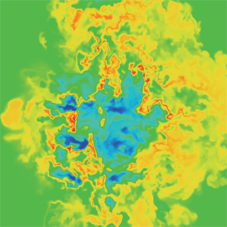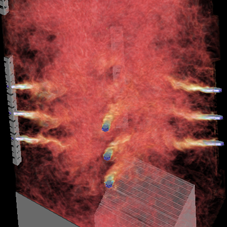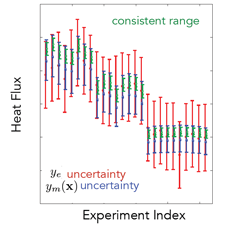|
The Carbon-Capture Multidisciplinary Simulation Center (CCMSC) is demonstrating exascale computing with V&V/UQ to more rapidly deploy a new technology for providing low cost, low emission electric power generation to meet the growing energy needs of the U.S. We are using a hierarchal validation approach to obtain simultaneous consistency between a set of selected experiments at different scales embodying the key physics components (large eddy simulations, multiphase flow, particle combustion and radiation) to predict performance in a 350MWe oxy-fired boiler. To solve this problem, we are developing the following tools:
The CCMSC is funded by the Predictive Science Academic Alliance Program.
Predictive Science The Predictive Science Team is focusing on four key physics components that will improve the predictivity of simulations of the 350 MWe oxycoal-fired boiler: The Predictive Science Team is focusing on four key physics components that will improve the predictivity of simulations of the 350 MWe oxycoal-fired boiler:
1. turbulent fluid transport, 2. multiphase flow, 3. particle combustion, and 4. radiative heat transfer. Advances in these four areas will provide predictions of a wider range of phenomena, over a wider range of space and time scales, with improved predictive accuracy and reduced uncertainty, or at least a better understanding of the uncertainty in comparison to existing capabilities.We anticipate the majority of the disciplinary advances will come as a result of the tight coupling between the predictive science team with the exascale and V/UQ activities.
Exascale Computing and Software Our CCMSC will start with a proven computational platform (UintahX) and sequentially move to multipe taflop and eventually exascale computing. We will accomplish this transformation with three software infrastructure components: Our CCMSC will start with a proven computational platform (UintahX) and sequentially move to multipe taflop and eventually exascale computing. We will accomplish this transformation with three software infrastructure components:
1. the exascale runtime system, 2. TASC (Transparent Abstractions for Scalable Computing) representing a high-level, portable "assembly language" for scientific computation with transparent abstraction by using a sub-Turing, embedded domain-specific language, and 3. the data management and visualization infrastructure for dealing with large data and for connecting that data to the visualization and data analysis components.
V&V/UQ The V&V/UQTeam will both provide the basis for risk assessment of the new technology and drive the technical priorities and resource allocation for the research within the CCMSC. The results of the V&V/UQ process will determine which physics and which framework components are critical to the Center's success. The V&V/UQ Team is organized into five groups from three institutions: The V&V/UQTeam will both provide the basis for risk assessment of the new technology and drive the technical priorities and resource allocation for the research within the CCMSC. The results of the V&V/UQ process will determine which physics and which framework components are critical to the Center's success. The V&V/UQ Team is organized into five groups from three institutions:
1. verification 2. experimental data 3. surrogate model development 4. validation/uncertainty quantification 5. tools creation
|
Research HighlightsInternational CollaborationsThe need to reduce CO2 emissions is global, and the CCMSC is fostering international collaborations in support of its mission to demonstrate exascale computing with V&V/UQ to more rapidly deploy a new technology for providing low cost, low emission electric…
Read more
One-Dimensional Turbulence Modeling of Coal CombustionJames C. Sutherland, Babak Goshayeshi Overview High-fidelity simulation of turbulent…
Read more
SpatialOps-Nebo EDSLJames C. Sutherland, Matthew Might & Christopher Earl, Tony Saad Overview Programmers for…
Read more
Visualization ResearchLarge-scale analysis and visualization is becoming increasingly important as…
Read more
Particle CombustionParticle Reactions Combustion of the coal is at the heart of the boiler. The mass release…
Read more
|
